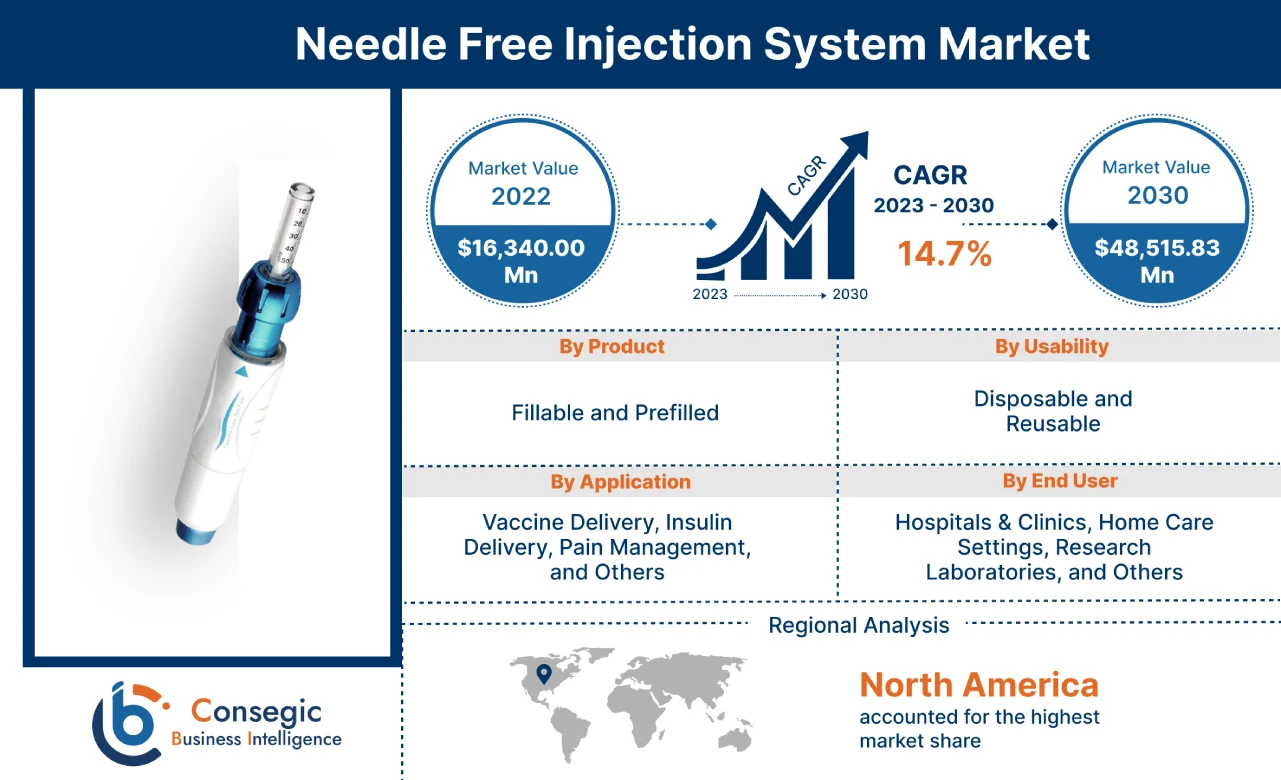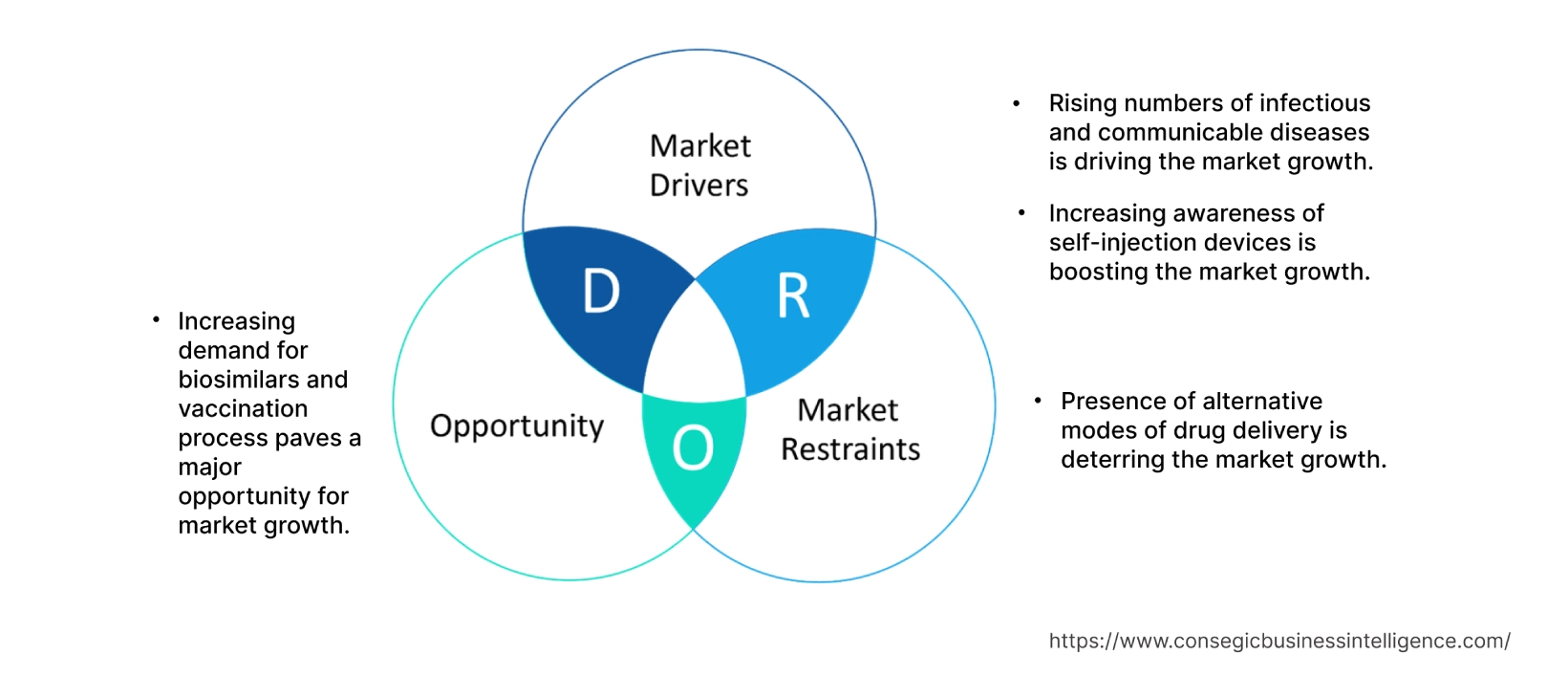- Summary
- Table Of Content
- Methodology
Needle Free Injection System Market Size :
Consegic Business Intelligence analyzes that the needle free injection system market size is growing with a CAGR of 14.7% during the forecast period (2023-2030), and the market is projected to be valued at 48,515.83 million by 2030 from 16,340.00 million in 2022.
Needle Free Injection System Market Scope & Overview:
Needle free injection system is a device that delivers medication into the body without the use of a needle. There are several different types of needle-free injection systems, but they all work by using a high-pressure stream of fluid to penetrate the skin and deliver the medication. Needle-free injection systems are also known as jet injectors. Needle-free injection systems is a cost-effective product that enhances the consumer experience. These products are embraced by the World Health Organization and mitigate any challenges due to needle reuse, cross-contamination, and needlestick injuries. Based on the analysis, needle-free injection technologies have wide usage in injecting liquid formulations, along with injecting drugs and vaccines in a solid dosage form. These products can be taken in the form of inhalers, edible products, power sprays, and others. Needle free injection system avoids piercing of the skin with a conventional needle.
Needle Free Injection System Market Insights :
Key Drivers :
Rising numbers of infectious and communicable diseases is driving the market growth
Needle free injectable system is a safe method of drug delivery, and the system mitigates any risk of infectious and communicable diseases. The product has certain advantages such as low drug dosage requirement, site-specific delivery of drugs, and minimized hospital stays. The needle free injection system market is experiencing positive trends due to the high risk of needlestick injuries, which results in large numbers of communicable and infectious diseases and also patient reluctance to use conventional needles. As per the analysis, needlestick products have potential threats such as hepatitis, AIDS among healthcare workers. For instance, according to the statistics published by the WHO, around 38% of the hepatitis cases and 4.5% of the AIDS cases in the healthcare sector is due to needlestick injuries. Thus, mitigating any health risks and safety threats associated with needlesticks has been the primary growth factor for the needle free injection system industry.
Increasing awareness of self-injection devices is boosting the market expansion
Self-injection devices are devices that allow people to inject themselves with medication without the help of a healthcare professional. Needle-free injection systems are a type of self-injection device that does not use needles. Needle free injections are self-injection systems that provide a faster method of delivering drugs. The rising need for needle free injectors due to concerns such as needle phobia is driving the market trends. Moreover, as per the analysis, these products are widely utilized as they are very convenient to use, reduce hospital stays, and minimize the healthcare costs involved. Needle free injection method of drug delivery is flourishing at a significant rate due to rising awareness of self-injection devices. Thus, owing to the aforementioned advantages of self-injection devices, the market of needle free injection system is experiencing significant trends.
Key Restraints :
Presence of alternative modes of drug delivery is deterring the market growth
Alternate modes of drug delivery such as the topical route of drug administration act as a major restraint for the needle free injection system market trends. It has certain challenges involved such as it leaves residues on the skin after usage, among others. Hence, there has been a greater requirement for alternative modes such as topical routes of drug administration. Based on the analysis, this type of drug delivery is considered better than injection systems as it is easy to use and can be directly applied to the skin. Certain product types of topical route of drug administration involve gels, lotions, ointments, and powders. Hence, certain advantages of the topical route of drug administration such as easy administration, and minimal systematic effect, among others are hampering the needle free injection system market growth.
Future Opportunities :
Increasing demand for biosimilars and vaccination process paves a major opportunity for market growth
High demand for biosimilars for the treatment of various diseases such as diabetes, cancer, and anemia, among others, is expected to drive the needle free injection system market demand. Needle free injection system is widely used in biosimilars as they are easy to use and have a safe and healthy approach. Prefilled needle free injection product is widely required for vaccination purposes such as vaccination for paediatric patients, chronic disease patients, and others. Moreover, based on the analysis, new innovative product launches by various needle-free injection manufacturers are likely to create lucrative avenues for the needle free injection system market opportunity. For instance, in May 2022, Pulse NeedleFree, one of the leading manufacturers of needle-free delivery technologies, launched its first disposable needle-free injector. This injector system has the primary focus of livestock vaccination. Thus, advanced product launches by the manufacturers are expected to boost the market during the forecast period.
Needle Free Injection System Market Report Insights :
| Report Attributes | Report Details |
| Study Timeline | 2017-2030 |
| Market Size in 2030 | USD 48,515.83 Million |
| CAGR (2023-2030) | 14.7% |
| By Product | Fillable and Prefilled |
| By Usability | Disposable and Reusable |
| By Application | Vaccine Delivery, Insulin Delivery, Pain Management, and Others |
| By End User | Hospitals & Clinics, Home Care Settings, Research Laboratories, and Others |
| By Region | North America, Europe, Asia-Pacific, Latin America, and Middle East & Africa |
| Key Players | Terumo Corporation, Pulse NeedleFree, PharmaJet, Portal Instruments, Medical International Technology Inc, NuGen Medical Devices, Crossject, Inovio Pharmaceuticals, Antares Pharma, Inc, and Penjet Corporation |
Needle Free Injection System Market Segmental Analysis :
By Product :
The product segment is categorized into fillable and prefilled. In 2022, the fillable segment accounted for the highest market share and is expected to grow at the fastest CAGR in the overall market. The fillable based needle free injection system is widely utilized due to its environmentally friendly nature. Moreover, as per the analysis, fillable products have wide availability and a high adoption rate in the market. For instance, in May 2022, Terumo Pharmaceutical Solutions, manufacturer of injection, primary container, and infusion therapy devices, launched pre-fillable polymer syringe for the main application of ophthalmic drugs and high-value drug applications such as intravitreal injection. Hence, due to advanced product launches by the key players in the market, the fillable segment is foreseeing significant expansion in the market.
By Usability :
The usability segment is categorized into disposable and reusable. In 2022, disposable segment accounted for the highest market share and is expected to grow at the fastest CAGR in the overall market. These types of needles are widely utilized to take blood samples and vaccines. For instance, in August 2021, Zydus Cadila received Emergency Use Authorization (EUA) from the Drug Controller General of India (DCGI) for ZyCoV-D. It is the First Plasmid DNA COVID-19 Vaccine Delivered Exclusively with the PharmaJet Needle-free Injection System. Thus the the aforementioned increases the expansion of the disposable segment.
By Application :
The application segment is categorized into vaccine delivery, insulin delivery, pain management, and others. In 2022, the vaccine delivery segment accounted for the highest needle free injection system market share of 41.05% in the market due to rising cases of chronic disease globally. The rise in chronic conditions and infectious diseases across the globe has led to high demand for vaccination. Also, from the time of COVID-19, the requirement for self-injectable devices and mass vaccination has increased in different regions globally. Moreover, the increasing vaccination demand for pediatric patients and mass vaccination campaigns are acting as catalysts for the expansion of needle free injection system market. For instance, according to the report published by UNICEF in July 2023, vaccination rates are increasing positively from 81% in 2021 to 83% in 2022. The report also mentions the global coverage rate for the third dose of the DTP vaccine increased from 81 % in 2021 to 84% in 2022. Hence, increasing vaccination programs is driving the trends of vaccine delivery in needle free injection system market.
Moreover, the pain management segment is expected to grow at the fastest CAGR in the overall needle free injection system market during the forecast period. This is owing to rising cases of medical conditions such as arthritis, pain disorders, and migraine globally. Also, increasing cases of chronic pain, migraine, tension headache, and cluster headache, among others are expected to foster the trends of the pain management segment during the forecast period.
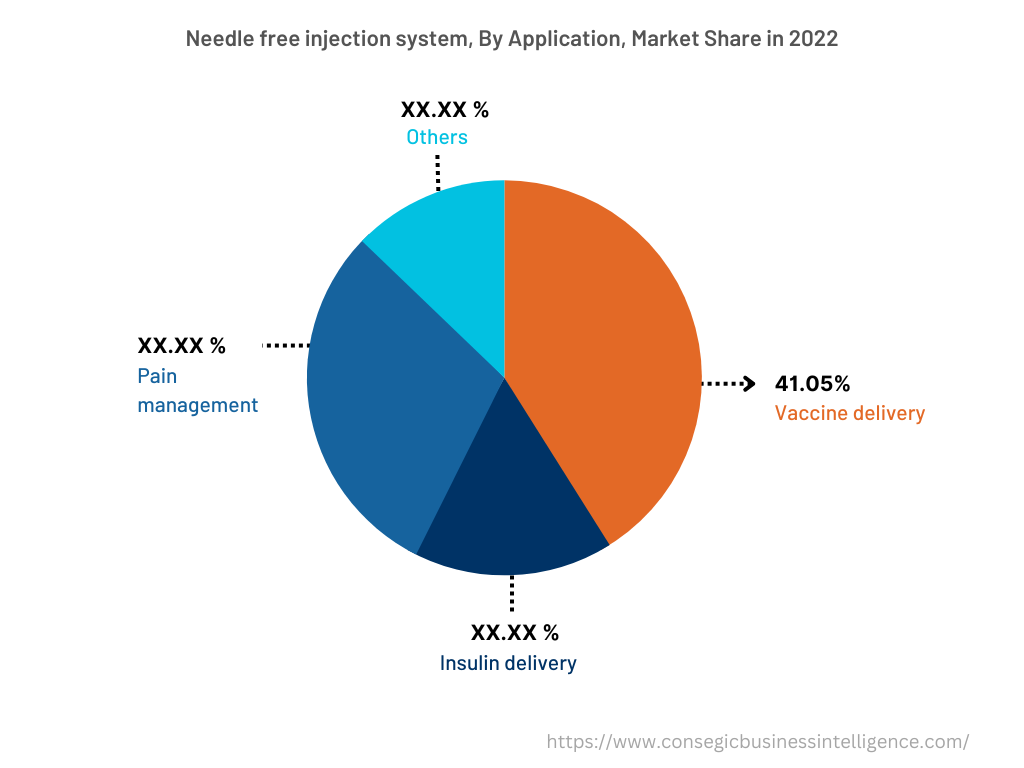
By End-User :
The end user segment is categorized into hospitals & clinics, home care settings, research laboratories, and others. In 2022, the hospitals & clinics accounted for the highest market share and is expected to grow at the fastest CAGR in the overall needle free injection system market. Needle free injections have wide usage in hospitals in operation theatres, outpatient departments, emergency rooms, and others. The rising number of hospitals across the globe coupled with the rising demand for vaccination in hospitals globally is driving segmental trends. Moreover, technological advancement such as advanced medical treatments in private hospitals globally is acting as a catalyst for the segment trends. For instance, according to Invest India, the hospital industry in India is expected to reach around USD 132 Billion by the end of the year 2023 from USD 61.8 Billion in 2017, growing at a CAGR of around 16%. Thus, the increasing number of hospitals is directly influencing the trends of hospitals & clinics globally.
By Region :
The regional segment includes North America, Europe, Asia Pacific, the Middle East and Africa, and Latin America.
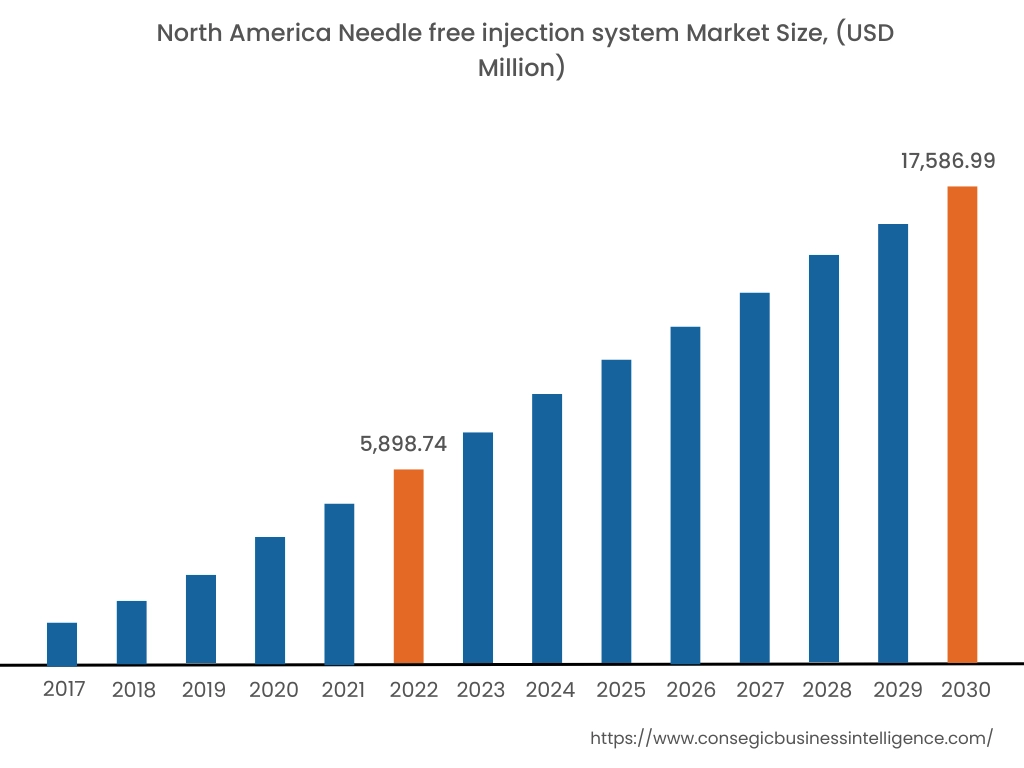
In 2022, North America accounted for the highest market share of 36.10% and was valued at USD 5,898.74 million and is expected to reach USD 17,586.99 million in 2030. In the North America region, the U.S. accounted for the highest market share of 65.15% during the base year 2022. Based on the needle free injection system market analysis, the increasing demand for these systems is attributed to the high presence of market players, coupled with highly developed healthcare systems in North America, specifically in the U.S. and Canada. Also, the rising number of chronic and lifestyle-associated diseases is significantly influencing the market trends of these system in North America. For instance, according to a recent report by the Centers for Disease Control and Prevention, chronic diseases such as heart disease, cancer, and diabetes are the leading causes of death in the U.S. These diseases have accounted for approximately USD 4.1 trillion in annual healthcare costs. Thus, the increasing number of chronic patients in the U.S. is significantly impacting a larger growth rate in the needle free injection system market.
Moreover, Asia Pacific is expected to grow at the fastest CAGR of 15.4% during the forecast period due to favorable government initiatives for the use of medical devices in countries such as India and China. Moreover, the rising healthcare expenditure and increase in private sector hospitals and clinics is contributing to the growth of needle free injection system market in the region. For instance, in 2023, according to an article by the Ministry of Health and Family Welfare, the Union Government's share accounted for 12.14% of the current health expenditure. As a result, the increasing government expenditure in the healthcare sector is anticipated to boost the market growth during the forecast period.
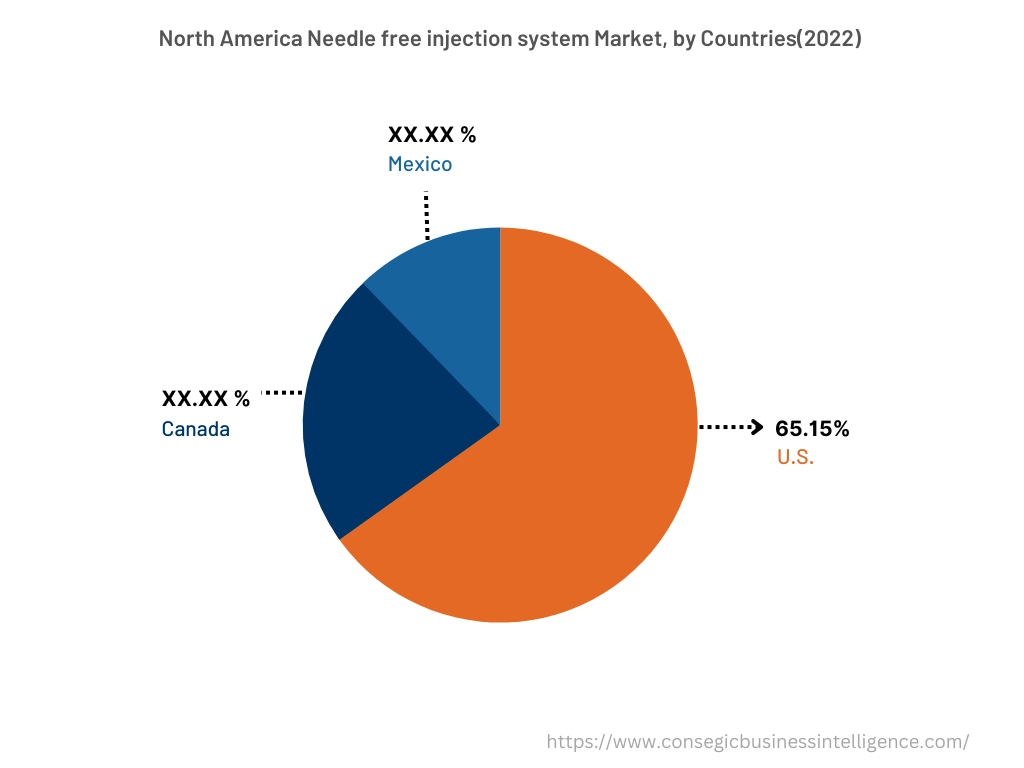
Top Key Players & Market Share Insights:
The global needle free injection system market is highly competitive, with several large players and numerous small and medium-sized enterprises. These companies have strong research and development capabilities and a strong presence in the market through their extensive product portfolios and distribution networks. The market is characterized by intense competition, with companies focusing on expanding their product offerings and increasing their market share through mergers, acquisitions, and partnerships. The key players in the market include-
- Terumo Corporation
- Pulse NeedleFree
- Inovio Pharmaceuticals
- Antares Pharma, Inc
- Penjet Corporation
- PharmaJet
- Portal Instruments
- Medical International Technology Inc
- NuGen Medical Devices
- Crossject
Recent Industry Developments :
- In December 2022, Terumo Corporation launched G-Lasta Subcutaneous Injection 3.6 mg BodyPod, which is a drug-device combination product. The product has been co-developed with Kyowa Kirin Co. Ltd. Terumo has developed the automated injection device of the product by leveraging its expertise in medical device engineering.
- In April 2022, PharmaJet launched a new interactive website, which offers improved access to needle-free data and applications. The website provides an enhanced user experience and highlights the performance that can be achieved with needle-free delivery.
Key Questions Answered in the Report
What was the market size of the needle free injection system market in 2022? +
In 2022, the market size of needle free injection system market was USD 16,340.00 million
What will be the potential market valuation for the needle free injection system market by 2030? +
In 2030, the market size of needle free injection system will be expected to reach USD 48,515.83 million.
What are the key factors driving the growth of the needle free injection system market? +
Rising numbers of infectious and communicable diseases globally is the key factor driving the growth of the needle free injection system market.
What is the dominating segment in the needle free injection system market by application? +
In 2022, the vaccine delivery segment accounted for the highest market share of 41.05% in the overall needle free injection system market.
Based on current market trends and future predictions, which geographical region will have the fastest impact on the needle free injection system market's growth in the coming years? +
Asia Pacific is expected to be the fastest-growing region in the market during the forecast period.
